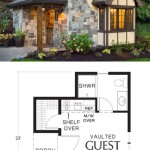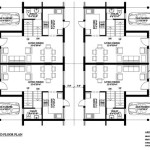Simple DIY House Plans: A Comprehensive Guide
Planning a house construction project can be a daunting task, particularly when aiming for a cost-effective and personalized solution. Simple DIY house plans offer an attractive alternative to hiring architects and construction firms, granting homeowners a greater degree of control over the design, functionality, and budget of their future residence. This guide will explore the fundamentals of DIY house plans, outlining key considerations, resources, and potential challenges involved in bringing a dream home to fruition.
The term "DIY house plan" encompasses a wide spectrum of approaches, ranging from modifying pre-existing plans to creating entirely custom designs from scratch. Regardless of the chosen method, a successful DIY project hinges on a solid understanding of architectural principles, building codes, and construction techniques. A careful assessment of personal skills and available resources is crucial before embarking on such an ambitious endeavor. The scope of the project will largely depend on the homeowner's experience and comfort level with tasks such as drafting, structural engineering, and permitting processes.
Several advantages are associated with opting for DIY house plans. Most significantly, it can lead to considerable cost savings by eliminating or reducing professional fees. It also grants the homeowner complete creative control over the design, ensuring that the final product perfectly aligns with their specific needs and preferences. Furthermore, the hands-on involvement in the planning process fosters a deeper understanding of the house's structure and systems, which can prove invaluable for future maintenance and renovations.
However, it is essential to acknowledge the potential drawbacks. Creating a house plan requires a significant time commitment and demands a certain level of technical expertise. Navigating building codes and obtaining necessary permits can be complex and time-consuming. Furthermore, any errors or omissions in the design can lead to costly revisions or even structural problems down the line. Therefore, a realistic assessment of one's capabilities and a willingness to seek expert guidance when needed are paramount.
Understanding the Basics of House Plans
Before delving into the specifics of creating a DIY house plan, it is crucial to grasp the fundamental components of a standard architectural drawing set. A complete set typically includes several types of drawings, each serving a distinct purpose. These drawings work together to provide a comprehensive representation of the proposed construction.
Site Plan: This drawing illustrates the location of the house on the property, showing its relationship to property lines, setbacks, easements, and existing structures. It also includes information about topography, landscaping, and utilities.
Floor Plans: Floor plans provide a top-down view of each level of the house, depicting the arrangement of rooms, hallways, doors, windows, and other interior features. They include dimensions, room names, and locations of fixtures and appliances.
Elevations: Elevations show the exterior views of the house from different sides, typically north, south, east, and west. They depict the roofline, windows, doors, and exterior finishes.
Sections: Sections are vertical cut-through drawings that reveal the interior construction details of the house, such as wall framing, floor joists, and roof rafters. They provide a clearer understanding of how the different components of the house are assembled.
Foundation Plan: The foundation plan outlines the layout of the foundation, including footings, foundation walls, and any supporting piers or columns. It specifies the dimensions, materials, and construction methods for the foundation.
Electrical Plan: This plan indicates the location of electrical outlets, switches, lighting fixtures, and other electrical components. It also shows the wiring routes and the size of the electrical service panel.
Plumbing Plan: The plumbing plan illustrates the layout of water supply lines, drainpipes, and plumbing fixtures, such as toilets, sinks, and showers. It indicates the pipe sizes, materials, and the location of the water heater and other plumbing equipment.
HVAC Plan: This plan shows the layout of the heating, ventilation, and air conditioning (HVAC) system, including the location of the furnace, air conditioner, ductwork, and vents. It specifies the size and type of equipment and the airflow requirements.
Understanding these different types of drawings is essential for creating a comprehensive and accurate DIY house plan. Each drawing provides critical information that is needed for construction, permitting, and future maintenance.
Steps to Creating DIY House Plans
The process of creating DIY house plans can be broken down into several key steps, each requiring careful consideration and attention to detail. The first step is defining the project scope and requirements. This involves identifying the homeowner's needs, preferences, and budget constraints. The second step is developing a conceptual design, which includes sketching out the floor plan and elevations. The third step is creating detailed construction drawings, which provide all the information needed for building the house. The fourth step is obtaining permits and approvals from local authorities.
1. Define Project Scope and Requirements: Begin by creating a detailed list of needs and wants. Consider the size of the house, the number of bedrooms and bathrooms, the desired style, and any special features, such as a home office, workshop, or outdoor living space. Establish a realistic budget and timeline for the project. Research local building codes and zoning regulations to ensure compliance. This initial assessment will serve as a roadmap for the entire planning process.
2. Develop a Conceptual Design: Start by sketching out rough floor plans and elevations. Experiment with different layouts to find the best arrangement of rooms and spaces. Consider factors such as natural light, ventilation, and traffic flow. Utilize online resources and design software to create more detailed visual representations of the conceptual design. Don't hesitate to seek feedback from friends, family, or online communities to refine the design.
3. Create Detailed Construction Drawings: Once the conceptual design is finalized, it is time to create detailed construction drawings. This involves using architectural software or drafting tools to produce accurate and comprehensive drawings of all aspects of the house, including the site plan, floor plans, elevations, sections, foundation plan, electrical plan, plumbing plan, and HVAC plan. Ensure that all drawings are clearly labeled and dimensioned, and that they comply with local building codes and standards. If necessary, consult with a structural engineer to ensure the structural integrity of the design.
4. Obtain Permits and Approvals: Before starting construction, it is essential to obtain all necessary permits and approvals from local authorities. This typically involves submitting the construction drawings and other required documents to the building department for review. The building department will assess the plans to ensure compliance with building codes, zoning regulations, and other applicable standards. Be prepared to make revisions to the plans based on the building department's feedback. Once all permits are approved, construction can begin.
5. Potential Challenges and Solutions: While DIY house plans offer numerous benefits, they also come with their fair share of challenges. These may include difficulties in navigating building codes, complex structural calculations, and time-consuming permitting processes. Addressing these challenges requires careful planning, diligent research, and a willingness to seek expert advice when needed. Consider consulting with a structural engineer, architect, or experienced contractor to ensure the project's success.
Resources for DIY House Plans
A wide range of resources are available to assist aspiring DIY house planners. These resources can provide valuable information, inspiration, and practical guidance throughout the planning process. From online software and templates to professional consultations and educational materials, these resources can empower homeowners to create their dream homes.
Online Software and Templates: Numerous online software programs and template libraries offer user-friendly tools for creating house plans. These programs allow homeowners to design floor plans, visualize elevations, and generate 3D models of their future homes. Many of these programs also offer features such as automatic code checks and cost estimation tools. Some popular options include SketchUp, AutoCAD Architecture, and Chief Architect.
Pre-Designed House Plans: If creating a custom plan from scratch seems overwhelming, consider using pre-designed house plans as a starting point. These plans are available from various online sources and can be modified to suit individual needs and preferences. Pre-designed plans offer a cost-effective and time-saving alternative to creating a completely custom design.
Professional Consultations: While the goal is DIY, seeking professional guidance at key stages of the planning process can be invaluable. Consulting with a structural engineer, architect, or experienced contractor can help ensure that the design is structurally sound, code-compliant, and buildable. These professionals can also provide valuable insights into optimizing the design for cost-effectiveness and energy efficiency.
Educational Materials: Numerous books, articles, and online courses offer comprehensive information on house planning and construction. These resources can help homeowners learn about architectural principles, building codes, construction techniques, and project management. Investing in these educational materials can enhance understanding of the planning process and avoid costly mistakes.
Embarking on a DIY house plan project requires a significant commitment of time, effort, and resources. However, with careful planning, diligent research, and a willingness to learn, it is possible to create a custom home that perfectly aligns with individual needs and preferences. By leveraging the available resources and seeking expert guidance when needed, homeowners can successfully navigate the challenges and achieve their dream of building a personalized and affordable residence.
Est House Plans To Build Simple With Style Blog Eplans Com

Easy To Build Houses And Floor Plans Houseplans Blog Com

Http Thehomesteadingboards Com Forums Construction And Diy Projects 1 A Simple 24x20 Cabin Tiny House Living Small Plans

Awesome Small And Tiny Home Plans For Low Diy Budget Craft Mart

27 Adorable Free Tiny House Floor Plans Craft Mart

Tiny Log Cabin Kits Easy Diy Project Small Cabins
:max_bytes(150000):strip_icc()/tiny-house-58f8ea1e3df78ca1597b528a.jpg?strip=all)
4 Free Diy Plans For Building A Tiny House

Floor Plans Learn How To Design And Plan

16 Cutest Tiny Home Plans With Cost To Build Craft Mart

11 Best 2 Bedroom House Design Ideas Bungalow
Related Posts








